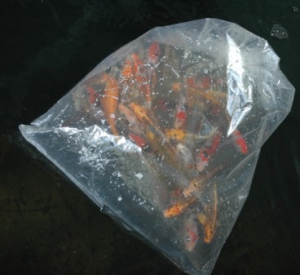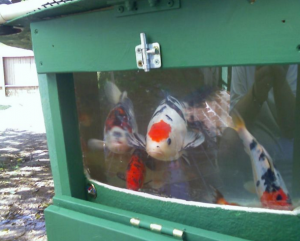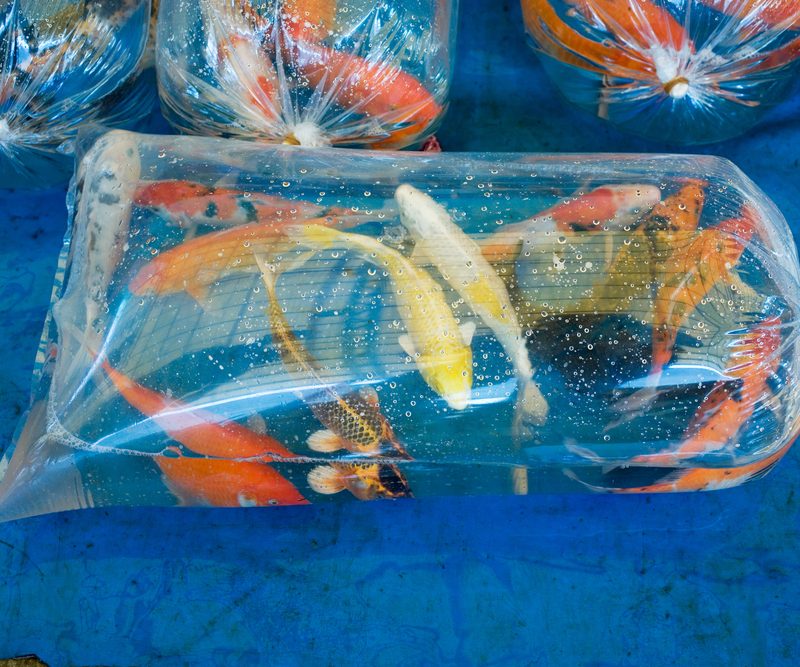Spring is coming. It’s almost time to get those new koi that you’ve been dying to add to the collection since the weather turned cold. Remember, however, there is a correct way to get them into their new home.
Step 1
Remember that bag under the tape is plastic. Use caution removing the packing tape. A sharp object will puncture the bag. Ours are double bagged for extra protection in case one bag is damaged in transit. Remove whatever is in the box for temperature control (like ice packs or a climate shield). Leaving it in the box temporarily can help with both light and temperature regulation.
The koi has also spent some time in total darkness so if you can hold off ripping into the box at noon outside on a sunny day your koi might be more appreciative of that, too.
Here’s a video about the steps we take to prepare our koi for shipment.
Step 2
After you’ve opened the box, look through the bag to check the condition of the koi. If the koi in the bag is immobile, floating or gasping for air at the water surface, get it out of the bag and into fresh water ASAP. Normal acclimation protocol is secondary to getting the overstressed koi out of the bag. Monitor the koi closely.
If there are any fish that don’t appear to be doing well or haven’t made the trip, take photos of it for your own records, and to provide photographic evidence for the company from whom you purchased the fish if you will be looking for a refund.
 Step 3
Step 3
Place the entire bag with the fish on the surface of the body of water you will be releasing them into. This practice is recommended for at least 30 minutes, depending on the temperature of the water. However, if the fish looks overly stressed or its behavior changes, then get it out of the bag and into the water of its new home (which should hopefully be a quarantine tank) as quickly as possible.
Step 4
Ordinarily the bag is closed with rubber bands. Either remove them or carefully cut the twisted portion of the bag off to open the bag. Make sure that there is still a cuff on the bag, though.
Take another look at your koi with the bag now open. When handling the koi, be gentle. Do it by hand or use a sock net. The last thing an already-stressed koi needs is slime coat damage. Your koi is going from one stressful environment into another. It can use a little tenderness.
DO NOT dump the koi and bag water into the new environment. It adds extra waste and will throw the pH out of balance—not good for your new fish or any of the other occupants.
Step 5
A stressed koi is a jumpy koi. More than one koi owner has come outside to a new koi lying on the outside of its new home. Pond netting is a good and fairly inexpensive option. Make sure that whatever is used is secured, however, and not sagging into the water. You don’t want your koi becoming entangled in the net. This Do-It-Yourself article offers a guide on how to secure leaf netting.
The Water Parameters Question
Many enthusiasts advocate for incrementally adding pond or quarantine tank water into the bag to adjust the pH slowly. In the past, this was the commonly accepted convention. New thinking, however, is that adding water can cause an unsafe spike in the ammonia levels inside the bag. Every 1.0 pH change can create 10 times more toxicity in ammonia.
Currently, the philosophy is—after temperature adjustment—to put the koi directly into its new abode. A quick pH difference shift all at once is a better alternative to the koi sitting for longer than necessary in water with questionable amounts of Oxygen and excess waste products (like CO2 and ammonia).
Temperature Adjustments
This is a big consideration in acclimation. Koi are hardy fish, but if the temperature swing is too vast, it can result in damage to the metabolism which if severe enough will result in death.
The time of year that you buy your fish will have a big part to play in that, too. Going from cold to warm water is an easier adjustment than warm to cold.
The box your koi comes in will often be kept at a lower temp to slow the koi’s metabolism for the journey. Slower metabolism means less waste. Less waste means better water quality. Which means a generally healthier and less stressed koi.
Remember, the koi is in a bag so putting the bag in direct sun can have an adverse effect on the water temperature. The process should be gradual to allow the koi to adjust slowly. Plus, in the shade the water will be cooler and the temperature gradient less severe. If there isn’t any shade, put a towel over the bag.

Quarantining
Beyond acclimating your koi to their new home, any owner should consider quarantining their new additions for up to a month, regardless of where you bought them or where they came from. Besides allowing you to check for infection or illness, it allows your new koi to decompress and get used to their new water parameters in a controlled environment.
Test Fish for New Pond
As much as you need to acclimate your fish, you will need to season your pond. Building up beneficial bacteria for the nitrogen cycle are critical to combatting high levels of ammonia in a pond. Clear water can still be lethal to koi.
Inexpensive Koi Grab Bags can be helpful in this regard. They can act as your “coalmine canaries” and also help with the seasoning process without risking more costly koi. Losing koi is never ideal, but if you are spending a significant amount of money, you want your koi to be given the best possible chance at survival.


Good advice here
I would really appreciate some info! I have 3 large koi now in an aquarium that I’ve had for years. They’re big now! I recently bought a home with a nice pond and waterfall that has 2 nice gold fish that the previous owner left. I would like to add my 3 large koi. how can I do this safely. I live in Houston.
Thanks!
We put two new koi fish into pond with 5 others, and they are still hiding in the rock crevices after they swam around for a minute or two.
When will they be comfortable enough to join the others?
It certainly isn’t uncommon for new fish to seek hiding areas to not only recover from stress, but will readily go there as well just to rest or remain from view if skittish. One way to try getting them more out in the open and is to get them in a same time of day feeding routine. A good time to check would be the early morning or late evening hours, as fish are naturally more active during these times. They may be out and about then.